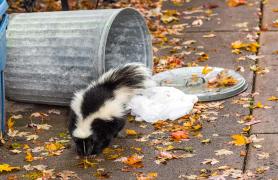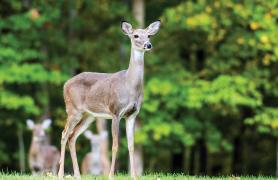The woods in winter may seem silent and still, but there’s plenty of life to be found if you know where to look.
Look
Scan leafless branches for the papery nests of bald-faced hornets. In summer, each nest may contain 400 hornets. But don’t worry. Only a few queens survive during winter.
Did You Know?
During cold weather, flying squirrels snuggle together in hollow trees. Their furry bodies can warm the den by 30 degrees, and the more squirrels there are, the toastier it gets. Fifty squirrels have been found packed into a single tree!
Take a Closer Look
If you find an artist conk fungus growing on a tree, use a stick to scratch the mushroom’s snow-white underside. Like magic, wherever you scratch will turn dark.
Look
Ozark witchhazel is among the first plants to bloom in Missouri. The shrubby trees unfurl frilly, flashy flowers in mid-January — sometimes when snow still blankets the ground.
What Happened Here?
This opossum isn’t dead. It’s just pretending. If predators approach, these furry fakers often faint, slobber, and release stinky fluid from their rear ends. Yuck! When this happens, most predators lose their appetites.
Listen
In winter, owls call to attract a mate. Here’s how to tell hoo’s looking
for love.
- Barred owl Who cooks for you? Who cooks for you all?
- Great horned owl Hoo, HOO, hoo-hoo.
- Eastern screech-owl High-pitched, horselike whinny.
Take a Closer Look.
Look carefully inside tree cavities and along branches, and you might find a screechowl taking a nap. The camouflage pattern on its feathers makes the little owl all but invisible against a barky background.
Did You Know?
Although they’re one of Missouri’s mightiest mammals, black bears give birth to itty-bitty babies. Born in February while mama bear’s asleep in her winter den, newborn cubs are about 15 times smaller than human babies.
Look
When you're surrounded by woods, you're bound to find woodpeckers. The headbanging birds are easy to locate by their harsh calls and their rat-a-tat tapping on trees. Here are five common woodpeckers to watch for.
- Red-bellied woodpecker
- Red-headed woodpecker
- Hairy woodpecker
- Downy woodpecker
- Pileated woodpecker
Also In This Issue


And More...
This Issue's Staff
Les Fortenberry
Karen Hudson
Angie Daly Morfeld
Noppadol Paothong
Marci Porter
Mark Raithel
Laura Scheuler
Matt Seek
David Stonner
Nichole LeClair Terrill
Stephanie Thurber
Cliff White






















